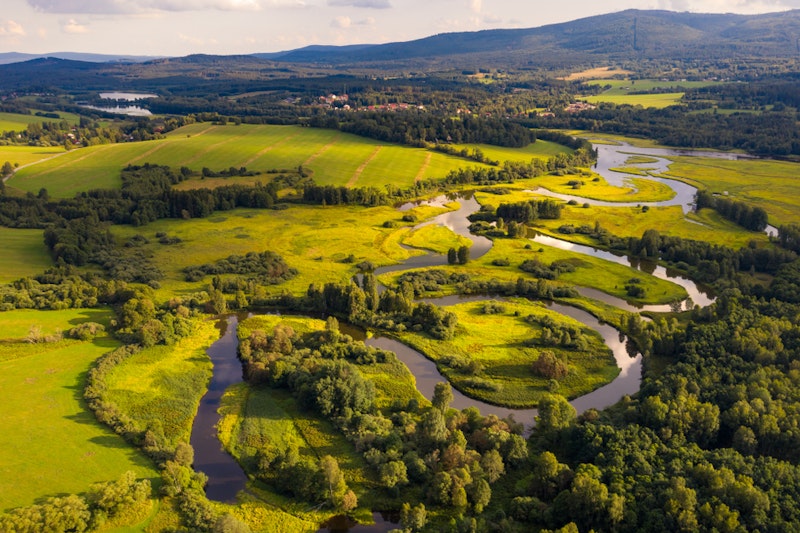Study Notes
GCSE Geography | The River Long Profile (River Landscapes 2)
- Level:
- GCSE
- Board:
- AQA, Edexcel, OCR, Eduqas
Last updated 17 Oct 2024
The long profile of a river shows how the gradient changes as the river flows from source to mouth. The gradient is steep in the upper course, more gentle in the middle, and almost flat in the lower course.

The Bradshaw Model
This is a theoretical model that helps us describe the changes that occur as the river flows downstream. It is shown as a series of triangles – if the triangle widens downstream it means that the variable increases, so we can see according to the model (in the image below) that channel depth and width, along with mean velocity, discharge and volume of load, all increase as the river flows from source to mouth. Whereas load particle size, channel bed roughness and gradient all decrease – shown by the triangles tapering off.

Characteristics of the upper course
In the upper course there is high relief and steep gradient – meaning lots of potential energy, despite having low velocity and small discharge. There is a narrow shallow channel where trickles merge to form rivulets, which coalesce to create a single channel or stream. The river bed is rough with large angular rocks on the bed.
- Erosion in the upper course is mainly vertical, and the process of hydraulic action
- Transportation in the upper course is mostly traction, with large boulders rolled along the river bed
- Deposition occurs in the upper course with large boulders dropped
Landforms - waterfalls, gorges, v-shaped valleys and interlocking spurs.

Characteristics of the middle course
In the middle course the relief of the land is lower – less mountains and hills so the gradient of the river reduces. Along this section the channel gets deeper and wider, and tributaries join the main river, meaning that lots of extra water joins the channel, so the velocity and discharge are both quite high. The river bed is smoother than the upper course, and sediment is smaller and less rough.
- Erosion in the middle course begins to erode laterally (sideways) into the valley sides, with less vertical erosion, meaning the valleys are wider. This erosion is mainly abrasion and attrition
- Transportation in the middle course is with material of a smaller average particle size as attrition takes place – leading to suspension
- There is a lot of deposition, particularly on the, inside of meander bends
Landforms - meanders and oxbow lakes.

Characteristics of the lower course
In the lower course the land is low lying with wide flat landscapes, and as a result the river’s gradient is almost flat. The channel is at its widest and deepest here, with high velocity and discharge and the river bed is smooth and covered in alluvium.
- In the lower course there is less erosion, and it is only lateral. However the river is at its most powerful as the velocity is greatest here
- In the lower course there is a large load made up of tiny particles so transportation is in the form of suspension or solution
- The main fluvial process here is deposition – fine sediment known as alluvium builds the flood plain when the river bursts its bank – this is extremely fertile so is good for crop growing
Landforms - levees, flood plains, and estuaries or deltas.

Why does discharge and velocity increase as you go downstream?
Discharge:
In order to calculate river discharge you need to work out the cross-sectional area first...
cross-sectional area (m²) = average depth(m) x width(m)
Discharge is the volume of water passing through a given point along the river. Measured in cubic metres per second (cumecs).
discharge (m³/s) = velocity (m/s) x cross-sectional area(m²)
One key reason why discharge increases downstream is that tributaries join the main river channel and increase its volume.
Velocity:
Although the gradient is steep in the upper course, the smaller channel size means there is a lot of friction with the bed and banks (known as the wetted perimeter) relative to the overall channel size (cross-sectional area), meaning a slower, average flow rate.
In the lower course, the river channel is wider and deeper. It is because there is less water is in contact with the bed and banks relative to the overall volume of water transferred, that it has a more efficient channel shape. Greater efficiency means higher velocity.
Bed roughness also reduces with distance from the source, reducing friction.
You might also like
River Landscapes - GCSE MCQ Quiz
Quizzes & Activities
Physical Landscapes of the UK - GCSE MCQ Quiz
Quizzes & Activities
Tri-Dominoes - River Landscapes (Paper 1) | Revision Activity
Teaching Activities
